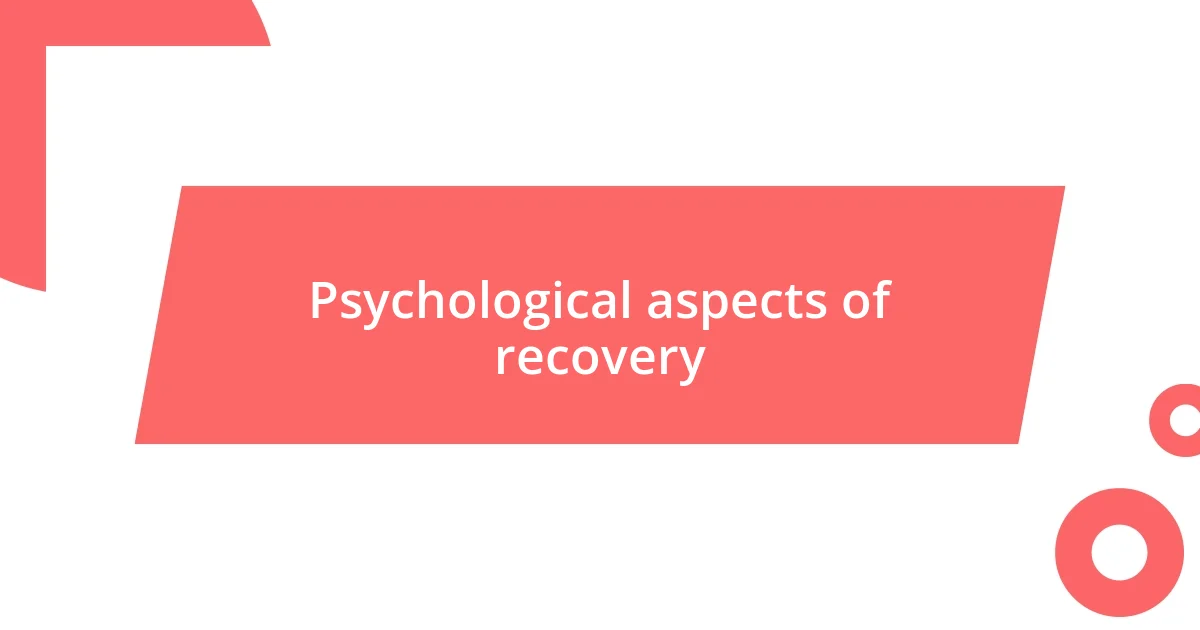Key takeaways:
- The injury recovery process involves both physical healing and emotional adjustment, highlighting the importance of mental resilience and self-compassion.
- Assessing injury severity is crucial; paying attention to pain levels, mobility, swelling, and symptom duration informs treatment decisions.
- Nutrition and hydration significantly impact recovery; incorporating nutrient-rich foods and staying hydrated can enhance healing and overall well-being.

Understanding injury recovery process
In my experience, the injury recovery process is a journey marked by both physical healing and emotional adjustment. Often, we assume that healing solely involves the body mending itself. However, I’ve found that mental resilience plays just as crucial a role. Have you ever felt frustration creeping in when progress seems slow? I certainly have—it’s easy to feel disheartened when the timeline doesn’t match our expectations.
During my recovery from a significant injury, I learned that understanding the stages of healing is vital. Initially, I was focused solely on pain management and mobility. Yet, as I progressed, I realized that educating myself about my injury helped me regain control and feel empowered. Knowledge truly is a powerful tool when you’re navigating the uncertainties of recovery.
One thing I’ve come to appreciate is the importance of patience and self-compassion throughout the process. There were days when I felt eager to push my limits, only to be met with setbacks. Those moments taught me that recovery isn’t always linear—it’s a series of peaks and valleys. Embracing this rollercoaster made all the difference in how I approached each milestone, transforming what could have been a frustrating journey into a more manageable, understanding experience.

Assessing the injury severity
When assessing the severity of an injury, I’ve found that it’s crucial to listen to my body and understand the signals it sends. For instance, after I sprained my ankle, I initially dismissed the pain as something minor. However, it became clear that I needed to acknowledge my discomfort fully. Here are some factors I consider during this assessment:
- Pain level: How intense is the pain? Is it sharp, dull, or throbbing?
- Mobility: Can I move the injured area? Or is there a significant loss of function?
- Swelling and bruising: Are there visible signs of swelling or discoloration?
- Duration of symptoms: Has the pain or discomfort persisted for more than a few days without improvement?
Recognizing these signs helped me make informed decisions about whether to seek professional advice or take a more cautious approach. I remember feeling a mix of apprehension and determination as I evaluated my situation, but ultimately, taking this step empowered me in my recovery journey. Understanding injury severity not only guides my treatment but also shapes my mental preparedness for what lies ahead.

Creating a recovery plan
Creating a tailored recovery plan is pivotal in navigating the injury rehabilitation process. I’ve learned that simply going through the motions isn’t enough; I actively engaged in outlining specific goals and timelines for my recovery. For example, when I strained my shoulder, I set immediate objectives like improving my range of motion within two weeks. Filling out a physical therapy worksheet not only clarified my path but also helped keep me motivated. Have you ever set a personal milestone during recovery? It can make the challenging moments feel more manageable.
As I embarked on creating my own recovery plan, I often encountered the dilemma of balancing ambition with caution. It’s easy to be overzealous, especially when you’re eager to regain functionality. During my own recovery, I made it a point to incorporate rest days and gentle exercises to promote healing instead of risking another setback. The realization hit me when I pushed too hard one week and faced increased pain the next—this taught me that patience, alongside intentional planning, is fundamental. How do you find the balance between pushing through and giving your body the rest it needs?
Reflecting on my experiences, I found that adjusting my plan as I progressed was just as critical as creating it in the first place. Adapting my activities based on how I was feeling day by day allowed me to be more in tune with my body’s needs. For instance, after a particularly challenging therapy session, I learned to incorporate more mindfulness practices like stretching and breathing exercises. I believe that cultivating resilience during recovery is about continuously listening to one’s body and making necessary adjustments. It’s a personalized journey that evolves with you.
| Key Components | Actions to Take |
|---|---|
| Goal Setting | Establish realistic milestones while allowing room for flexibility. |
| Balance | Monitor your body’s responses and adjust your efforts accordingly. |
| Adaptation | Continuously assess your progress and modify the plan for optimal recovery. |

Implementing rehabilitation techniques
Implementing rehabilitation techniques requires a blend of structured approaches and mindful flexibility. For instance, during my recovery from a knee injury, I found success with physical therapy exercises focused on strength and stability. I remember feeling a mix of frustration and determination when some exercises seemed simple but pushed my limits in unexpected ways. Isn’t it fascinating how our bodies can surprise us, revealing both weaknesses and strengths during rehabilitation?
Incorporating elements like stretching and strengthening exercises into my routine became a vital part of my recovery strategy. I sometimes felt hesitant to push through pain, especially when I worried about potential setbacks. I recall one specific day when I tried to skip some stretches because I felt rushed, only to experience tightness that afternoon. That moment taught me to never underestimate the importance of consistent practice. Have you ever had a similar experience where a small oversight led to unforeseen challenges?
Furthermore, I realized that blending my rehabilitation with enjoyable activities made a significant difference. For example, I started doing water aerobics, which was not only gentle on my joints but also surprisingly fun. The laughter and light-heartedness of being in the water helped ease my stress. I encourage you to explore activities that elevate your mood and keep your spirits high during recovery. Embracing rehabilitation techniques doesn’t just mean enduring pain; it’s about discovering joy and resilience amid the challenge, wouldn’t you agree?

Monitoring progress and adjustments
Monitoring my progress during recovery has been a real game-changer for me. Each day, I would jot down my feelings and any changes in my body, which helped me to recognize patterns over time. I remember one week where my pain levels were surprisingly low, and I couldn’t help but wonder: was my body finally starting to heal? This simple act of logging my experience turned out to be a motivational tool, as it highlighted even the smallest improvements.
I’ve also learned that being flexible in my recovery plan is essential. There were days when my body felt fatigued and required lighter exercises, so I adjusted accordingly. It was during one of those unexpected restful days that I realized I needed to listen closely to what my body was telling me, rather than stubbornly sticking to a predetermined schedule. Have you ever felt that gentle push to change your plans based on how you felt? It’s those moments that often lead to the most significant breakthroughs in progress.
In addition to observing my own feelings, I found that tracking my achievements visually—through graphs or progress photos—added a layer of excitement to my recovery journey. I distinctly remember taking a photo after a particularly challenging session where I finally bent my knee with ease. Seeing that tangible proof of progress filled me with pride and renewed my commitment. It’s remarkable how a visual representation of your hard work can fuel your motivation, don’t you think? Monitoring progress isn’t just a technical aspect of recovery; it’s a deeply personal experience that propels you forward.

Nutrition for optimal recovery
Nutrition played a crucial role in my recovery, and I soon discovered that what I fed my body directly influenced how I felt and healed. For instance, after my injury, I made a concerted effort to incorporate more protein-rich foods into my meals. I still remember the first time I tried a post-workout smoothie filled with spinach, bananas, and protein powder; the energy boost was palpable, and it felt like a small victory after a difficult session. Isn’t it amazing how the right nutrients can transform not just our bodies, but also our mindset?
I found that focusing on whole foods, like fruits and vegetables, helped reduce inflammation, which was a game changer. One day, while snacking on berries, I thought about how those tiny powerhouses were working to combat my discomfort. It was something as simple as knowing that the antioxidants in those berries were serving a purpose that impacted my recovery journey, making me feel empowered. Have you ever considered how your food choices can either support your progress or hold you back?
Hydration also became a cornerstone of my recovery plan. I vividly recall a particularly grueling day when I felt fatigued and challenged myself to drink more water. The simple act of hydrating transformed my performance during my exercises, boosting my stamina and clarity. It’s such a small yet significant detail that many overlook. Staying hydrated not only energizes the body but also aids in recovery, and it taught me a valuable lesson: sometimes, the fundamental things can make the biggest difference. Isn’t it fascinating how our body responds to the little things we do for it?

Psychological aspects of recovery
The psychological aspects of recovery played a significant role in my healing journey. I found that my mindset could either uplift me or weigh me down. For instance, when I struggled with feelings of frustration after not meeting a goal, I took a step back to acknowledge those emotions rather than pushing them aside. This allowed me to process what I was feeling and remind myself that recovery is a marathon, not a sprint. Have you ever felt like your emotions were holding you back? I believe that embracing those ups and downs can ultimately lead to more profound healing.
Visualization techniques became a part of my mental toolkit as well. I vividly remember lying in bed, picturing myself moving freely and pain-free. This practice not only gave me hope but also strengthened my determination to get there. It was as if I could almost feel that freedom just by imagining it. Has visualization ever helped you in a tough spot? I’ve found that painting a mental picture of success can be a powerful motivator when facing setbacks.
Additionally, connecting with others who were on a similar recovery journey brought me immense comfort. I remember joining an online support group and sharing my experiences, which surprisingly lifted a heavy weight off my shoulders. The collective wisdom and encouragement from others made all the difference. It’s striking how community support can change our perspective, don’t you think? Engaging with others not only helps us realize we’re not alone but also reaffirms that recovery is as much about the mind as it is about the body.















